雾都孤儿文学评论-nancy性格分析
雾都孤儿南希
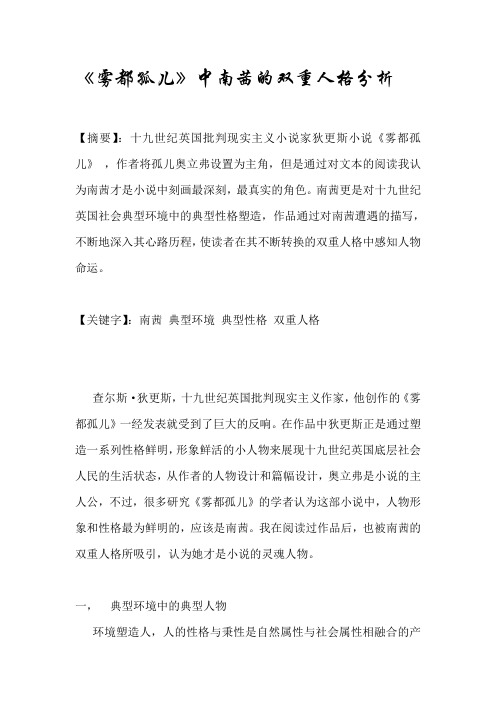
《雾都孤儿》中南茜的双重人格分析【摘要】:十九世纪英国批判现实主义小说家狄更斯小说《雾都孤儿》,作者将孤儿奥立弗设置为主角,但是通过对文本的阅读我认为南茜才是小说中刻画最深刻,最真实的角色。
南茜更是对十九世纪英国社会典型环境中的典型性格塑造,作品通过对南茜遭遇的描写,不断地深入其心路历程,使读者在其不断转换的双重人格中感知人物命运。
【关键字】:南茜典型环境典型性格双重人格查尔斯·狄更斯,十九世纪英国批判现实主义作家,他创作的《雾都孤儿》一经发表就受到了巨大的反响。
在作品中狄更斯正是通过塑造一系列性格鲜明,形象鲜活的小人物来展现十九世纪英国底层社会人民的生活状态,从作者的人物设计和篇幅设计,奥立弗是小说的主人公,不过,很多研究《雾都孤儿》的学者认为这部小说中,人物形象和性格最为鲜明的,应该是南茜。
我在阅读过作品后,也被南茜的双重人格所吸引,认为她才是小说的灵魂人物。
一,典型环境中的典型人物环境塑造人,人的性格与秉性是自然属性与社会属性相融合的产物,是人的生理心理在微观环境中内化的结果。
南茜走上的罪恶之路,不是由于她与生俱来的劣根性,而是资本主义社会下的必然产物,是典型环境中的典型人物,是十九世纪英国工业革命下底层人民的缩影。
四五岁时,面临着饥饿而死还是做贼求生的选择,他没有过多道德方面的评判,活下去是其唯一想要的。
在求助无门的困苦中,最终落入费根团伙,成为其偷盗工具,最终惨死在自己的同伙亦是她爱人的棍棒之下。
南茜的命运是千千万万底层人民的命运,但是南茜的人格却是复杂的,她的美好与丑陋,她的善良与邪恶,她的交错的性格构成了小说中最为典型的人物。
二,优美的人性1,南茜之真人性之真,便是能毫不掩饰地追求心中所愿你,所望。
而南茜之真便是表达在她对爱情的狂热与执着,正是这份执念,表达了南茜最为真实的一面。
暗无天日的社会,通向死亡的途径有更多,死是最轻易而为的事情,年幼的南茜还未能对这个世界有一个清醒的认知便落入了老犹太费根团伙,这不是作者的可以安排,这是法国十九世纪社会的真实写照。
读书心得——《雾都孤儿》南希角色分析

读书心得——《雾都孤儿》南希角色分析查尔斯·狄更斯是19世纪英国著名作家,是现实主义文学创始人,其作品《雾都孤儿》可谓是世界文学史中重要的代表作品。
在《雾都孤儿》一书中,虽说主人公是奥利弗,但作者对南希这一角色的塑造也非常成功,引起了广大读者的巨大反响。
从角色定位来说,南希的角色更加具备现实教育作用,狄更斯对南希这一角色性格、特征等描绘都运用了大量精炼的语句。
此外,对于南希的塑造,作者更是特别设计了许多矛盾对立体,以此来为这一角色双重性格的描绘埋下伏笔。
一、南希角色产生背景一是时代背景,狄更斯所处时代正是英国全盛时期,19世纪是英国工业快速发展时期,社会各个行业都呈现繁荣景象,然而在这繁荣背后却隐藏着基层工人阶级的潦倒和不幸。
南希这一角色正是在这一时代背景下产生的,该角色的塑造是当时社会的真实映照,更是对当时社会的深刻批判和抨击。
二是家庭背景,作者狄更斯出生于贫困家庭,年少时由于父亲负债累累,全家人不得不居住在贫困街区中,与社会最底层群众接触较多。
而狄更斯为了补贴家用,小小年纪便要到鞋油厂挣钱,这样的家庭环境使得狄更斯从小便缺乏安全感,现实的悲惨和对未来的憧憬让狄更斯形成了孤僻和光明并重的双重性格。
因此可以说,南希这一角色的诞生并非是作者凭空想象,而是作者自身的真实写照。
狄更斯能够对南希角色的复杂性格、行为、心理进行准确刻画和把握,便是以其自身童年经历为基础。
二、南希角色特点分析(一)外在罪恶。
《雾都孤儿》中最能够体现出南希外在罪恶的情节便是她联合同伴绑架奥利弗到费金家中。
奥利弗跟两个同伴一起干活,却不知所干之事属于盗窃行为,后来被警察抓住后,由于书摊主人的证词证明了偷盗之人并非是奥利弗,而后又得到了布朗劳先生的帮助,将奥利弗带回家中,并受到管家贝德温的照顾。
而奥利弗的两个小伙伴为了避免奥利弗出卖他们,鼓动南希将奥利弗挟持回来。
虽然南希一开始并不愿意,但最终还是将奥利弗从布朗劳先生家中带了出来,破坏了奥利弗平静、幸福的生活。
浅析雾都孤儿中南希人物形象终稿
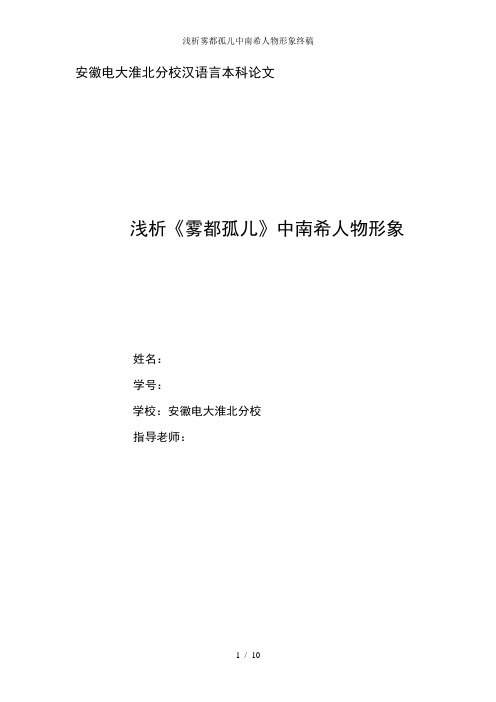
安徽电大淮北分校汉语言本科论文浅析《雾都孤儿》中南希人物形象姓名:学号:学校:安徽电大淮北分校指导老师:目录摘要、关键词---------------------------------------------------------------一、南希的苦难形象 --------------------------------------------------------- 1二、南希的“邪恶”形象 ----------------------------------------------------- 2三、南希的“善良”形象 ------------------------------------------------------ 3四、南希的机智勇敢形象 ------------------------------------------------------ 5五、结语 -------------------------------------------------------------------- 6 注释------------------------------------------------------------------------ 6 参考文献--------------------------------------------------------------------- 7[论文摘要]南希是《雾都孤儿》中一个次主要角色,但却是小说中一个极为典型的人物。
她从小生活在贼窝中,帮助犯罪分子为非作歹。
她遇到奥利弗时,良心发现,巧妙地发挥自己的聪明才智,机智勇敢地帮助奥利弗逃出贼窝,但自己却不幸被犯罪分子杀害。
在她身上,“邪恶”与“善良”这两种截然不同的性格不断交织,她的一生充满悲剧色彩。
[关键词]《雾都孤儿》;南希;人物形象浅析《雾都孤儿》中南希人物形象《雾都孤儿》原名为《奥利弗﹒退斯特》,是狄更斯这位享誉盛名的作家代表作之一,于1838年出版,在英国文学史上,是一部非常成功的作品。
《雾都孤儿》中南希的双重性格分析

《雾都孤儿》中南希的双重性格分析作者:张蔚来源:《文教资料》2010年第32期摘要: 小说《雾都孤儿》中南希这一人物有着无比丰富、复杂的内心世界,具有典型的双重性格。
本文试从分析作者所处的时代特征、作者个人本身双重性格对塑造这一人物的影响入手,论述南希矛盾的人生观、世界观、价值观以及爱情观,进而呈现一个具有双重性格的人物。
关键词: 小说《雾都孤儿》南希双重性格一、时代特征与作者个人性格对塑造南希这一人物的影响文学作品来源于生活,可以真实地反映出作者所生活时代的烙印与自身生活的轨迹。
我们不难从狄更斯成长的历程中发现,他之所以能够成功地塑造如小说《雾都孤儿》中南希、大卫·科波菲尔这样具有典型双重性格的人物,与其生活的时代与家庭背景有着深层的联系。
也就是说,一个人的行为、思想、性格、观点等受现实社会影响极深。
1.时代特征狄更斯的创作,始终与时代潮流同步。
19世纪中叶是维多利亚女王时代初期,整个英国社会面临着飞速的经济发展与严重的社会问题,经历了由工业革命带来的惊天动地的变化。
一方面,一度被称为“世界工厂”的英国通过向海外发展市场与剥削殖民地的各种资源积累了大量财富,成为全世界的经济第一强国。
一时间拜金主义同功利主义被广泛接受,几乎每一件事都以效用为检验标准。
结果随之而来的是文化价值的贬低和人与人之间的冷淡。
在崇拜金钱的社会里,人们只顾赚钱,追求物质享受,而完全忽略了仁爱。
但在这繁荣与财富下掩盖的是工人阶级的贫困与不幸,为了谋生,连妇女和儿童都要受雇到艰险肮脏的工厂卖苦力。
可以说社会的阶级矛盾就已日趋尖锐。
而另一方面,维多利亚时期又是一个民主、普及教育、博爱萌芽时期。
因此,也存在具有仁爱品质的人。
作为这一时期代表的小说家,狄更斯的写作手法自然也包含两个方面,一方面主要以写实笔法揭露社会上层和资产阶级的虚伪、贪婪、卑琐、凶残,满怀激愤和深切的同情展示下层社会,特别是妇女、儿童和老人的悲惨处境,并以严肃、审慎的态度描写开始觉醒的劳苦大众的抗争。
《雾都孤儿》中南希是怎样的人物形象分析 有什么性格特点

《雾都孤儿》中南希是怎样的人物形象分析有什么性格特点(最新版)编制人:__________________审核人:__________________审批人:__________________编制单位:__________________编制时间:____年____月____日序言下载提示:该文档是本店铺精心编制而成的,希望大家下载后,能够帮助大家解决实际问题。
文档下载后可定制修改,请根据实际需要进行调整和使用,谢谢!并且,本店铺为大家提供各种类型的经典范文,如诗歌散文、原文赏析、读书笔记、经典名著、古典文学、网络文学、经典语录、童话故事、心得体会、其他范文等等,想了解不同范文格式和写法,敬请关注!Download tips: This document is carefully compiled by this editor.I hope that after you download it, it can help you solve practical problems. The document can be customized and modified after downloading, please adjust and use it according to actual needs, thank you!In addition, this shop provides you with various types of classic sample essays, such as poetry and prose, original text appreciation, reading notes, classic works, classical literature, online literature, classic quotations, fairy tales, experience, other sample essays, etc. if you want to know the difference Please pay attention to the format andwriting of the sample essay!《雾都孤儿》中南希是怎样的人物形象分析有什么性格特点【导语】:南希是《雾都孤儿》中的重要人物,关于南希是怎样的人一直受到关注。
《雾都孤儿》小说中南希的善恶形象研究

国外学者对南希角色的研究较为深入,涉及心理 学、社会学、女性主义等多个角度。
3
研究空白
尽管南希角色备受关注,但其在小说中的善恶形 象及其背后的社会历史原因仍有待深入挖掘。
研究内容与方法
研究内容
本研究将重点分析南希在小说中的言行举止,探讨其善恶形象的表现及成因, 同时结合19世纪英国社会历史背景进行考察。
对奥利弗的同情与帮助
在奥利弗遭受陷害后,南希的内心矛盾达到了顶点,她最终选择了站在善良的一 边,为奥利弗提供了帮助。
05
南希善恶形象对比及意义
善恶形象的矛盾统一
南希的善良本性
在小说中,南希虽然身处社会底层,却始终保持着一颗善良的心。 她同情奥利弗的遭遇,不惜冒着生命危险为他提供帮助。
南希的恶行
然而,南希也曾被迫参与盗窃团伙的犯罪活动,对他人造成了伤害 。她的这种行为与她的善良本性形成了鲜明的对比。
研究方法
采用文本细读法,对小说中的相关情节进行深入剖析;运用比较分析法,将南 希与其他角色进行对比研究;结合历史文献法,探究南希形象背后的社会历史 因素。
02
《雾都孤儿》小说简介
作者查尔斯·狄更斯生平
查尔斯·狄更斯(Charles Dickens)是19世纪英国最著名
的小说家之一。
他出生于1812年,一生创作了 多部经典小说,如《双城记》、
对南希形象的解读不够深入
本研究虽然对南希的善恶形象进行了分析,但未能深入挖掘其背后的社会、文化、心理等因素,未来可以进 一步拓展研究深度,揭示南希形象的更多层面。
对未来研究的展望
拓展其置于 更广阔的社会、历史、文化背景中进行考察,以揭示其更 丰富的内涵和意义。
她的形象让读者对于人性的善恶有了更深刻的认识,同时也引发了读者对于社会现实的 反思。
资本主义制度下的牺牲品:《雾都孤儿》中南希三重人格的弗洛伊德式解读
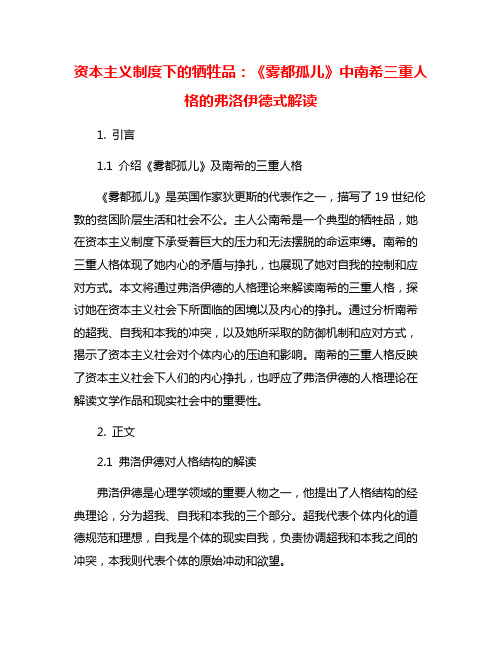
资本主义制度下的牺牲品:《雾都孤儿》中南希三重人格的弗洛伊德式解读1. 引言1.1 介绍《雾都孤儿》及南希的三重人格《雾都孤儿》是英国作家狄更斯的代表作之一,描写了19世纪伦敦的贫困阶层生活和社会不公。
主人公南希是一个典型的牺牲品,她在资本主义制度下承受着巨大的压力和无法摆脱的命运束缚。
南希的三重人格体现了她内心的矛盾与挣扎,也展现了她对自我的控制和应对方式。
本文将通过弗洛伊德的人格理论来解读南希的三重人格,探讨她在资本主义社会下所面临的困境以及内心的挣扎。
通过分析南希的超我、自我和本我的冲突,以及她所采取的防御机制和应对方式,揭示了资本主义社会对个体内心的压迫和影响。
南希的三重人格反映了资本主义社会下人们的内心挣扎,也呼应了弗洛伊德的人格理论在解读文学作品和现实社会中的重要性。
2. 正文2.1 弗洛伊德对人格结构的解读弗洛伊德是心理学领域的重要人物之一,他提出了人格结构的经典理论,分为超我、自我和本我的三个部分。
超我代表个体内化的道德规范和理想,自我是个体的现实自我,负责协调超我和本我之间的冲突,本我则代表个体的原始冲动和欲望。
通过弗洛伊德的人格结构理论,我们可以更深入地理解《雾都孤儿》中南希的三重人格。
南希作为资本主义制度下的牺牲品,承受着巨大的心理压力和挣扎,她的超我、自我和本我的冲突,反映了弗洛伊德理论中人格结构的复杂性。
南希的人格结构与弗洛伊德的理论有着深刻的联系,她的内心挣扎和防御机制都可以在弗洛伊德的理论中找到对应。
2.2 南希作为资本主义制度下的牺牲品南希作为资本主义制度下的牺牲品,在《雾都孤儿》中扮演着一个深受悲惨命运折磨的角色。
她是一个年幼被母亲遗弃的孩子,从小被迫进入社会的底层阶级,被剥夺了受教育的权利,被迫从事卑贱的劳动以维持生计。
南希的贫困和无助让她成为了资本主义制度下的牺牲品,她被迫放弃了自己的理想和尊严,只能顺从命运的安排。
在资本主义社会中,南希代表了那些被剥夺了自由和尊严的劳动者。
人性的抉择——浅析《雾都孤儿》中南希的人物形象

人性的抉择——浅析《雾都孤儿》中南希的人物形象董壮 201207002 公共事业管理(艺术学)《雾都孤儿》是英国作家狄更斯的第二部作品。
该作品以雾都伦敦为背景,以一个孩子为主角,通过一个无家可归的、被遗弃的、无父无母的男孩在成长过程中所遭受的苦难经历的描写,表现了个人的孤独、无助和软弱,揭露了整个社会的冷酷无情和麻木不仁。
然而,在《雾都孤儿》中,南希却一直扮演着一个良心未泯的角色,在善与恶之间不断的抉择。
如果简单的把《雾都孤儿》中的人物分为好人、坏人、伪君子和良心未泯的人四类,那么显而易见南希是四类人中的最后一类。
例如,在《雾都孤儿》中,当赛克斯提起监狱里的犯人受刑时,奥利弗感到南希的手在颤抖,脸色发白;当赛克斯要放狗咬奥利弗,费金要用打奥利弗时,是南希阻止了他们;在把奥利弗骗回来这事上,南希一直很后悔。
“‘···全能的上帝,保佑我吧,我会的。
’姑娘冲动的喊叫着,‘早知道要我出手把他弄到这儿来。
我宁可在街上给人打死。
或者跟咱们今晚路过的那个地方的人换换位子。
从今晚起他就是个贼,是骗子、魔鬼了,就这么坏。
那个老混蛋,还非得揍他一顿才满足吗?’”最后,南希向罗斯小姐告发了赛克斯的阴谋。
赛克斯是那么一个混蛋,她还是死心塌地跟着他,全心为他奉献。
从以上可以看出,南希是个身处乱世但良心未泯的好姑娘。
在《雾都孤儿》这部小说中,南希是善良的代表之一。
她出生于苦难之中,在黑暗和充满罪恶的世界中成长,但在她的心中始终保持着一片纯洁的天地,始终有着一颗善良的心。
种种磨难并没有使她堕落,反而更显示出了她坚强、圣洁、出淤泥而不染的高贵品质。
最后,邪不胜正,正义的力量战胜了邪恶,虽然南希惨死在强盗赛克斯的手中,但正因为她的死才召唤出惊大动地的社会正义力量。
正是她的死,注定了邪恶势力的代表——费金团伙的灭顶之灾。
其实,南希这一角色在一出场的外貌描写过程中,就为其复杂的人物形象的塑造埋下了伏笔。
读书心得——《雾都孤儿》中南希的人物形象分析
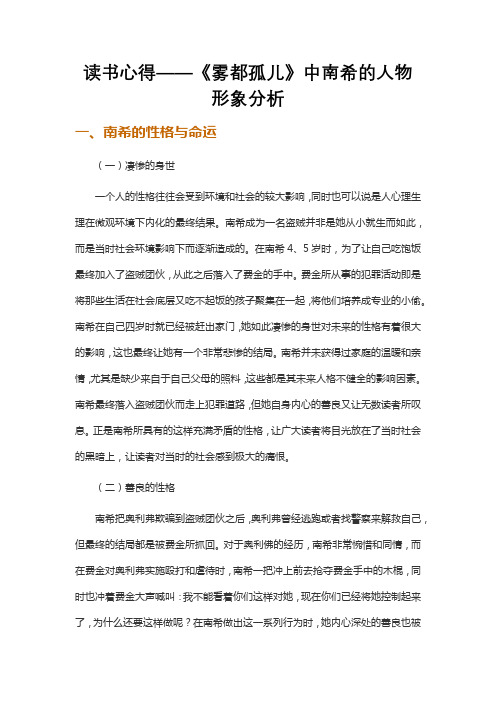
读书心得——《雾都孤儿》中南希的人物形象分析一、南希的性格与命运(一)凄惨的身世一个人的性格往往会受到环境和社会的较大影响,同时也可以说是人心理生理在微观环境下内化的最终结果。
南希成为一名盗贼并非是她从小就生而如此,而是当时社会环境影响下而逐渐造成的。
在南希4、5岁时,为了让自己吃饱饭最终加入了盗贼团伙,从此之后落入了费金的手中。
费金所从事的犯罪活动即是将那些生活在社会底层又吃不起饭的孩子聚集在一起,将他们培养成专业的小偷。
南希在自己四岁时就已经被赶出家门,她如此凄惨的身世对未来的性格有着很大的影响,这也最终让她有一个非常悲惨的结局。
南希并未获得过家庭的温暖和亲情,尤其是缺少来自于自己父母的照料,这些都是其未来人格不健全的影响因素。
南希最终落入盗贼团伙而走上犯罪道路,但她自身内心的善良又让无数读者所叹息。
正是南希所具有的这样充满矛盾的性格,让广大读者将目光放在了当时社会的黑暗上,让读者对当时的社会感到极大的痛恨。
(二)善良的性格南希把奥利弗欺骗到盗贼团伙之后,奥利弗曾经逃跑或者找警察来解救自己,但最终的结局都是被费金所抓回。
对于奥利佛的经历,南希非常惋惜和同情,而在费金对奥利弗实施殴打和虐待时,南希一把冲上前去抢夺费金手中的木棍,同时也冲着费金大声喊叫:我不能看着你们这样对她,现在你们已经将她控制起来了,为什么还要这样做呢?在南希做出这一系列行为时,她内心深处的善良也被激发了出来,这也是南希在进入盗贼团伙之后第一次对着费金表达自己的不满。
与此同时,在后来南希无意间听到了塞克斯和费金达成的阴谋协议后,她内心经历了非常激烈的思想斗争,于是将他们之间的秘密透露给罗斯,即便南希属于盗窃团伙中的一员,但她为了挽救奥利佛而最终被塞克斯所谋杀,即便南希做出了错误的选择加入盗窃团伙,但最终她内心的良知尚未泯灭,也在生命的最后时刻成为了读者心中一个美丽的天使[1]。
(三)矛盾的内心我们知道,南希是被逼迫与劝诱的方式将奥利佛再次拐回到盗窃团伙,我们从这件事能够看出南希自身的聪明与机灵。
《雾都孤儿》中南希的人物形象分析

《长江丛刊·理论研究》2017.08《雾都孤儿》中南希的人物形象分析梁雨珠【摘 要】南希是英国著名作家查尔斯狄更斯笔下的一位经典小说人物,是《雾都孤儿》这部作品中的重要人物之一。
借助于对南希的刻画,作者非常真实的为广大读者呈现出了过去伦敦社会底层人民的生活。
【关键词】雾都孤儿 南希 形象分析一、南希的性格与命运(一)凄惨的身世一个人的性格往往会受到环境和社会的较大影响,同时也可以说是人心理生理在微观环境下内化的最终结果。
南希成为一名盗贼并非是她从小就生而如此,而是当时社会环境影响下而逐渐造成的。
在南希4、5岁时,为了让自己吃饱饭最终加入了盗贼团伙,从此之后落入了费金的手中。
费金所从事的犯罪活动即是将那些生活在社会底层又吃不起饭的孩子聚集在一起,将他们培养成专业的小偷。
南希在自己四岁时就已经被赶出家门,她如此凄惨的身世对未来的性格有着很大的影响,这也最终让她有一个非常悲惨的结局。
南希并未获得过家庭的温暖和亲情,尤其是缺少来自于自己父母的照料,这些都是其未来人格不健全的影响因素。
南希最终落入盗贼团伙而走上犯罪道路,但她自身内心的善良又让无数读者所叹息。
正是南希所具有的这样充满矛盾的性格,让广大读者将目光放在了当时社会的黑暗上,让读者对当时的社会感到极大的痛恨。
(二)善良的性格南希把奥利弗欺骗到盗贼团伙之后,奥利弗曾经逃跑或者找警察来解救自己,但最终的结局都是被费金所抓回。
对于奥利佛的经历,南希非常惋惜和同情,而在费金对奥利弗实施殴打和虐待时,南希一把冲上前去抢夺费金手中的木棍,同时也冲着费金大声喊叫:我不能看着你们这样对她,现在你们已经将她控制起来了,为什么还要这样做呢?在南希做出这一系列行为时,她内心深处的善良也被激发了出来,这也是南希在进入盗贼团伙之后第一次对着费金表达自己的不满。
与此同时,在后来南希无意间听到了塞克斯和费金达成的阴谋协议后,她内心经历了非常激烈的思想斗争,于是将他们之间的秘密透露给罗斯,即便南希属于盗窃团伙中的一员,但她为了挽救奥利佛而最终被塞克斯所谋杀,即便南希做出了错误的选择加入盗窃团伙,但最终她内心的良知尚未泯灭,也在生命的最后时刻成为了读者心中一个美丽的天使[1]。
《雾都孤儿》中南希双重性格分析
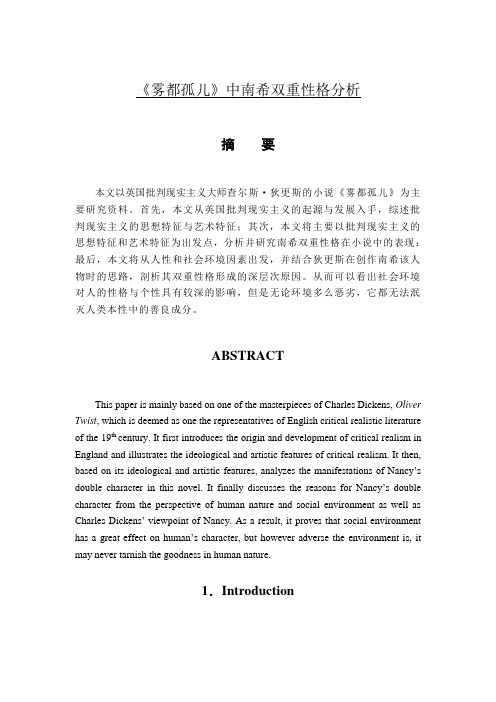
《雾都孤儿》中南希双重性格分析摘要本文以英国批判现实主义大师查尔斯·狄更斯的小说《雾都孤儿》为主要研究资料。
首先,本文从英国批判现实主义的起源与发展入手,综述批判现实主义的思想特征与艺术特征;其次,本文将主要以批判现实主义的思想特征和艺术特征为出发点,分析并研究南希双重性格在小说中的表现;最后,本文将从人性和社会环境因素出发,并结合狄更斯在创作南希该人物时的思路,剖析其双重性格形成的深层次原因。
从而可以看出社会环境对人的性格与个性具有较深的影响,但是无论环境多么恶劣,它都无法泯灭人类本性中的善良成分。
ABSTRACTThis paper is mainly based on one of the masterpieces of Charles Dickens, Oliver Twist, which is deemed as one the representatives of English critical realistic literature of the 19th century. It first introduces the origin and development of critical realism in England and illustrates the ideological and artistic features of critical realism. It then, based on its ideological and artistic features, analyzes the manifestations of Nancy’s double character in this novel. It finally discusses the reasons for Nancy’s double character from the perspective of human nature and social environment as well as Charles Dickens’viewpoint of Nancy. As a result, it proves that social environment has a great effect on human’s character, but however adverse the environment is, it may never tarnish the goodness in human nature.1.IntroductionCharles Dickens, the greatest representative of the English critical realistic literature of Victorian era, was born in February, 1812. In his childhood when he thought hi mself a ―very small and not-over-particularly-taken-care-of boy‖ [1]215, he was fond of playing outdoors and reading books, especially showing an ineffable interest in picaresque novels of Tobias Smollett and Henry Fielding. As a matter of fact, this period was an idyllic but significant time for his whole life for it had had a great influence on his works which later gained a worldwide reputation.As the founder and one of the eminent representatives of English critical realism in 19th century, Charles Dickens is responsible for some of English literature's most iconic characters [2]136. He is much loved by readers around the globe not only for his well-portrayed characters such as Oliver Twist and David Copperfield, but also for his exhaustive depiction of contemporary life as well as the relentless denouncement towards the dark social reality. His novels and short stories have never gone out of print. A concern with social reform is an eternal theme that runs throughout his every work. In his novels, he m aintains ―an unbroken faith in people with an entire pessimism as to capitalist society.‖[3]354The story is set in the 19th London. The hero, Oliver Twist, is adopted by an orphanage as soon as he was born. He can’t bear the poor and hungry life in that place, so he escapes. Unfortunately, however, he is kidnapped by the evil gang of Fagin. Although intimidated by force and beguiled with money, young Oliver is unwilling to steal. With the help of Nancy, Brownlow and other kind-hearted people, Oliver finally escapes from the abyss of vice and misery, finds out who he really is and leads a happy life. The wretched and tortuous experience of Oliver and Nancy is a living embodiment of author’s miserable childhood.From the perspective of the novel itself, Oliver Twist is not deemed as the quintessential representative work of Charles Dickens in the strict sense. Some scholars argue that Oliver Twist is a realist work smacking of romance for it exhibits some humorous language, comic characters and a happy ending to readers. As far as its historical and literary significance are concerned, however, Oliver Twist marks the beginning of the English realist literature in Victorian Era. Charles Dickens spares no efforts to reveal the hypocrisy and inhumanity of parish workhouse through the description of the little Oliver’s childhood in this novel. Furthermore, Dickens gives realistic pictures of the horrible existence in workhouse. One of the importantcharacteristics of the novel is the real and specific description of people who lived at the bottom of the capitalistic society. Their miserable lives are just the live mirror of the dark and evil sides of British society of 19th century. Those works aroused readers to think about the need of a nationwide social reform as well as the social reasons for all sorts of criminal phenomena at that time. Along with the success of this well-known novel, ―Dickens became more and more at odds with bourgeois society and more and more aware of (and exasperated by) the absence of any readily available alternative‖.[4]248In spite of her status as a secondary character in Oliver Twist, Nancy plays an irreplaceable part in the development of the novel. As a humble female thief in the gang of Fagin, Nancy is instigated to kidnap Oliver into this evil gang, but finally she sacrifices her own life to save Oliver from the abyss of miseries and sufferings. Due to the complexity in her character, Nancy has become a popular subject studied by some scholars.Although Charles Dickens was once criticized for molding a character of ―thieving, whoring, slut of the streets‖ [5]107, there is no doubt that Nancy is one of literature's earliest examples of the stock character of the ―tart with a heart‖—the stereotypical character of a tragic or fallen woman who makes her way through life by means of crime and often earns a wage as a prostitute, but is still a good and compassionate person.The thesis here is intended to introduce the rise and development of critical realism as well as its ideological and artistic features firstly; secondly, it will analyze Nancy’s double character from the perspective of the ideological and artistic features of critical realism; thirdly, it continues to bring out the reason for her tragedy from the perspective of the goodness of humanity and the influence of social reality on human nature.2. The review of critical realismIn the second half of 19th century, the entire English society witnessed an unprecedented and unrepeatable movement which caused vital changes in agriculture,manufacturing, mining, and transportation. Later on, it is known as the ―Industrial Revolution‖which then exerted a profound effect on the socioeconomic and cultural conditions in the England. Along with it there emerged English capitalism and bourgeois. As the working class continued to expand, they became more and more dissatisfied and cynical with their living conditions and social status. And the gap between working class and upper class became wider, which thus became the background where critical realism rose.2.1 Rise and development of English critical realismIn a strict sense, critical realism is a term applied to the realistic fiction in the late 19th and early 20th centuries which some writers and intellectuals in the period between 1875 and 1920 used to criticize and examine the serious social issues of that time. During this period suffused with intense class struggle appeared a new sort of literary trend—critical realism which flourished in the forties and in the early fifties of 19th century. It was described with a lot of vividness and great artistic skills by some critical realistic writers. The most important is that this new literature reflected the major traits of the capitalist society and criticized the capitalist system from the viewpoint of a democrat.Critical realism had achieved great success in Europe at one time. As the industrial capitalism continued to develop throughout the Europe and the contradiction between upper class and middle and lower class became increasingly intensified. Under this backdrop, critical realism took shape and gained its initial development in France in the 1920s. From 1930s to 1940s, critical realism became the mainstream of European literature after romanticism, which was generally considered as the real peak of critical realism. Gorky once thought it was a ―major, most splendid and useful literary school of 19th century‖. Critical realism originated in France. Red and Black of Stendhal laid a foundation for this literary trend and Human Comedy of Balzac symbolized the highest achievement of critical realism. Moreover, critical realists like Gustave Flaubert, Guy de Maupassant, Alexandre Dumasfils and Romain Rolland became famous with their sharply satirical works which formed the magnificent trend of critical realism of 19th century.While in Britain, in the meantime, there emerged a great many celebrated writers from the middle class. They were dissatisfied with the conditions both the country and its people are faced with at that time. Therefore, they spared no efforts to denounce the darkness and corruption of the society, sympathizes people from below and advocates social reforms so as to radically change the current condition of England. In the year of 1837, Charles Dickens (1812-1870) who has been regarded as one of the three hosts of Victorian novelists (another two are Thackeray and George Eliot) wrote the novel Oliver Twist which reflects the tortuous life of Oliver Twist and mirrors the miseries people living in the bottom of the English society suffered and repudiates the defects of capitalism. In 1844, Thomas Hood (1799-1845) wrote the poem The Song of the Shirt which, through the mouth of a poor seamstress, voiced the miserable life of the female workers. These works, to a great degree, showed the writers’ deep concern and sympathy for the workers and their protests against the exploitation of capitalism. Hence, those writers were usually considered as the earliest writers of critical realism in the English literature.Generally speaking, Charles Dickens and William Makepeace Thackeray were the mature statesmen of English critical realistic literature. They represented the middle and lower classes, exposing and criticizing the evil and corruptive aspects of capitalism. Charles Dickens creates pictures of bourgeois civilization and describes the misery and sufferings of the common people by means of striking force and truthfulness. The masterpieces of Charles Dickens range from Oliver Twist, David Copperfield, to Hard Times and A Tale of Two Cities. And the masterpiece of Thackeray is Vanity Fair. Although Thackeray’s was a no-class severe critic of contemporary society, his works had a deep effect on the writers that followed. As the English literary trends continue to flourish, the methods of critical realism were further adopted by such writers as Charlotte and Emily Bronte, Elizabeth Gaskell and George Eliot. Their works were intended to describe the pathetic life of the laboring people and criticized the privileged classes. Marx thought o f them as ―the outstanding novelists of contemporary England‖and he ind icated ―they have told the whole world what the politics and social truths are in their preeminent and vivid ly depicted works. As far as this point is concerned, they are much more critical and sarcastic than any other statesman and politics critic.‖2.2 The ideological and artistic features of critical realismCritical realism, in the western literature, refers to a literary trend or a creative method which come into being on the basis of the previous realistic literature in Europe in 19th century. It is generally assumed that critical realism is the continuation and development of the traditional realistic literature, which is fully manifested in its ideological and artistic features.2.2.1 The ideological features of critical realismSpecifically speaking, the ideological features of critical realism first lie in the exposure of the sin of capitalist society, which extends far more profound than ever before. Critical realists spare no efforts to reveal the bald individual interests in capitalist society: the lower class can hardly earn their living through their daily work; while the middle class become rich through exploiting the lower class and the upper class (mainly the aristocracy) enjoy their life leisurely with their old dignity and status.Secondly, critical realism takes literature as the means to analyze and study society and enable people to understand rich and colorful social and historical scenes of some certain periods, which is of magnificent cognitive value. Critical realists usually employ some writing techniques such as humor, exaggeration, and satire to reflect the real but miserable life of bottom people. Realistic novels by some famous writers are the mirrors of their time in which people who come along see the most reliable and vivid images of people’s life at that time.Thirdly, critical realism takes humanist thought as its main weapon, to profoundly expose and criticize the social darkness, sympathize the hardships of people living at the bottom of society and advocate social reform and improvement. The significance of critical realistic literature does not lie in whether critical realists have pointed out the correct and feasible solutions for their countries but in its exposure of the evil aspects of aristocracy and bourgeois and its reflection of the contradiction of capitalism by means of depicting the severe hardships people suffer, arousi ng people’s doubt about the feasibility and duration of this social system.Finally, realistic literature shows a great concern for people’s survival during the development of social civilization, chiefly epitomizing writers’ care for people’sdensity and future. The 18th and 19th centuries witnessed a liftoff in economy and productive force, but the social environment of ordinary people became grim. This is also the significance of existence and development of critical realism at that time.2.2.2 The artistic features of critical realismThe artistic features can be concluded as follows:In the first place, Critical realists highlight writers should observe the reality in a cool and reasonable way and depict the reality in a truthful and objective way. Most of them think of art as a mirror of real life. Some even specifically state that they want their works to be the records of the times. Therefore, their works widely reflect a variety of aspects of people’s life, even every corner of the society. In order to vividly and truthfully recreate the life of the era in which they live, those writers attach great importance to the description of details and make every piece of information as accurate as possible. The realistic works of 19th century are an artistic gallery exhibiting the process of the breakdown of feudalism and the rise of capitalism, which is a splendid page in the world literature history.In the second place, Critical realists create the typical characters in some certain environment. At the same time, they realize a human is the outcome of society so they attach great importance to the influence of environment on characters in their works. The writing attitudes of typification make the composure of the realistic writers of strong truthfulness. The disposition of typical characters is well contacted with the environment they live in. The successful characters have always been the unified typification of general and specific characteristics. And they are usually in different environment and contradictory collision, showing their different characteristics which change with the environment. When critical realists depict the typical character in some certain environment, they try their best to prove the accurate environment, incidents, characters as well as details of reality. They hold human beings as the outcome of some certain societies in which environment decides the action and destiny of characters. Critical realists depict characters and relate stories through the relationships between people and society. Meanwhile, they set stories in some certain background, describing the formation and changes of people’s character and the vicissitudes of people fate.In the third place, realistic literature is mainly narrative literature. Novels are the tools critical realists use to describe the reality and express their sentiment. In the meantime, novels gain great development and thus become mature and becomeprosper. After Charles Dickens and William Makepeace Thackeray, there emerged more novelists such as Charlotte Bronte, George Eliot and Thomas Hood, whose works also mirror all aspects of their social life.3. Analysis of Nancy’s double characterIn the English literature of 19th century, the theme of caring the destin y of ―little folks‖ and life of petty bourgeoisie is the most extensive and successful one, which we can easily see from the works of Sister Bronte or Thackeray. Both the social reality and the trend of literary creation had an imponderable influence on the Dickens’ works. Therefore, we can see that almost every novel is set in a broad social background, focuses on one family (mainly middle and small bourgeoisie family) . Dickens spares no efforts to mould a great many unforgettable female characters that have the same important status with the heroes. He has created hundreds of female characters of various characters and natures. They are linked, contrasted and set off among themselves, becoming the indispensible landscapes in his novels.Nancy has been considered the most attractive and successful character in Oliver Twist because of her typical double character which is fully manifested in this novel by Charles Dickens. As a young prostitute and one of Fagin’s former child pickpockets as well as Bill Sikes’s lover, Nancy is unable to get out of this criminal association. However, when the young and innocent Oliver comes into her eyes, her sense of moral decency comes into conflict because she sees a young and innocent herself in the eyes of Oliver Twist and that’s part of the reason why she sacrifices her own life in the end. The following paragraphs exemplify Nancy’s vicious and virtuous aspects and analyze her double character from the perspective of ideological and artistic features of critical realism.3.1 Manifestations of Nancy’s double characterNancy’s double character is fully manifested in Oliver Twist. The following parts here mainly focus on Nancy’s contradictory attitudes towards Oliver Twist, Fagin and Bill Sikes.3.1.1 The vicious aspects of NancyThe vicious aspects of Nancy are mainly manifested in what she has done for the sake of her master Fagin and her lover Bill Sikes as well as what she had done as apickpocket when she was as young as Oliver. Simply put, in order to help Fagin and Bill Sikes seek improper interest, Nancy cheats and hurts the innocent Oliver again and again. The following two paragraphs will set some examples of Nancy’s evil deeds.The first example is that: after Oliver was arrested for stealing, Nancy went to police station in nice and brightly colored clothes, pretending t o be Oliver’s distraught sister who was extremely worried about his little brother. There she learned from a police officer that the gentleman from whom the handkerchief was stolen took Oliver home with him. Instigated by Fagin, Nancy heads to Mr. Brownlow’s house. Outside Mr. Brownlow’s house, she pretends to want to have a word with Oliver. This innocent boy believes Nancy’s hypocritical words. As soon as Oliver steps out of the house, he is caught by Nancy. Nancy kidnapped Oliver on the way to the bookstall and finally dragged Oliver through the dark streets to Fagin’s house.The second example is that: when Fagin, Monks and Bill Sikes needed a child to help them get in the house to steal something valuable, they thought of Oliver. Oliver was the most suitable person to finish this task for he was thin and small enough to creep into the window and few people knew him even if he was caught. At that moment, they could only rely on Nancy to bring Oliver back to Fagin. Nancy chose to obey Fagin and Bill Sikes’order. Thus, Oliver was once again kidnapped from Mr. Brownlow’s house in which he felt happy and at ease. The pathetic Oliver was punished and instigated to help Fagin and Bill Sikes achieve their established goal. As a result, Oliver was detected when he entered that house, and he was shot and got hurt.3.1.2 The virtuous aspects of NancyThe virtuous aspects of Nancy are mainly manifested in her protection of Oliver and her final decision and act of helping Oliver out of Fagin’s evil gang. As far as these are concerned, Nancy is a girl immersed in degenerated and decayed environment but she is noble and honest in nature. The following two paragraphs are going to set a few examples of Nancy’s noble deeds in the novel.The first example is that: w hen Oliver was dragged to Fagin’s house, Fagin tried to punish Oliver with a stick. Nancy jumped to his defense for the first time, and yelled at Fagin:‖I thieved for you when I was a child not half as old as this (pointingto Oliver). I have been in the same trade, and in the same service, for twelve years since; don’t you know it? Speak out! Don’t you know it?‖It can be easily seen that Nancy is irritated about what Fagin has done and is going to do to Oliver. As for the boy who has almost the same unfortunate destiny with her, Nancy shows her sympathy for Oliver.Another example is when Nancy decides to help Oliver out of Fagin’s gang even though she knows she may lose her life for her disloyalty to Fagin and Bill Sikes. On that night, after managing to let Bill Sikes drink the wine with opium, Nancy went to meet Rose Maylie and Mr. Brownlow on London Bridge in a contradictory mood and told them Oliver’s whereabouts and the crimes of the Fagin’s gang. Nevertheless, she was killed by Bill Sikes after he knew it was Nancy Fagin who let out the whereabouts of Oliver Twist and she might even have let out some information about him and his business.The moment when Nancy was killed after saving Olive Twist, her soul got sublimated. This is the climax of the whole story because she finally differentiates vice and virtue and commits one of the noblest acts of goodness. The depiction of this character represents Dickens' view that man, however tainted by society, can still retain a sense of goodness.3.2 Analysis of her double character from the perspective of ideological featuresThe following paragraphs will mainly analyze the manifestations of double character from the above ideological features of critical realism.When Fagin, Monks and Bill Sikes need a slim child to help them get in Maylie’s house to steal something valuable, they think of Oliver. It is very natural that they will send Nancy to kidnap Oliver to help them finish their great plan. At that moment, Nancy is unwilling to hurt such an innocent boy again who has the similar fate like her on one hand. On the other hand, she does not want to disappoint Bill Sikes with whom she is deep in love. Although she finally does as Fagin tells, we can see the good and pure aspect of Nancy’s soul. After Oliver has been shot in the robbery to Maylie’s house, Fagin relates Oliver’s misfortune to Nancy. She cries that she hopes Oliver is dead. Because Nancy knows it too well that living with Fagin is worse than death.From the above description, it can be easily seen that the bald individual interests, selfishness and nonchalance in human nature are vividly exhibited in the novel. People in the early capitalist society do everything they can without any sense of responsibility and guilt in order to satisfy their own needs and desires regardless of whether and how other people will be hurt. From this example, it can be seen that the sin of capitalist society has been exposed through Nancy's life, which is typical of critical realism from ideological perspective.At that time when aristocracy gain their own interests by their old and corruptive dignity and capitalists meet their own needs by their increasing capital, people from the bottom of the society such as Fagin, Bill Sikes, Nancy and other pickpockets are exploited extremely heavily on condition that they live a legal and normal life. In order to meet her basic needs in the daily life, Nancy has to take a vicious road. Therefore, there emerges another ideological feature of critical realism: critical realism show great concern about ordinary people’s survival in the course of economic development and civilization advancement.As is known to us all, it is a law that we human beings are advancing for all time, but the material and spiritual civilization do not goes hand in hand especially those of the bottom people. Here Charles Dickens depicts a typical character Nancy to express his humanist thought towards the ordinary people. Nancy is brought up by Fagin in a selfish nonchalant and inhumane environment and she makes money by stealing and her identity as a prostitute. Dickens intends to expose and criticize the inhumane and unjust social phenomena by molding such a miserable and pathetic character. From this point, it can be seen that critical realism also characterizes in using humanist thoughts as its main weapon to criticize the darkness, degradation and corruption of capitalist society.3.3 Analysis of her double character from the perspective of artistic featuresAs the typical character in Oliver Twist, the complexity and duality in Nancy’s character embody the struggling and distortion of human nature in the typical 19th England, which conforms to the first feature of critical realism. It is no wonder that Nancy has been the most popular and attractive subject of many scholars and researchers.When Nancy decides to meet Mr. Brownlow and Rose on the London Bridge, she needs great courage to face those people who are nobler and more elegant than her. In others words, she is ashamed of her degraded status and humble identity which is the common characteristic of lower class in that background. For the purpose of saving Oliver, she discards her resisting emotion of meeting people from another world which is opposite to hers. But when she is offered an opportunity to return to the normal and virtue life, she discards it for she is going to stay with the man she loves even though she knows what she gets finally is not a happy ending. As far as this is concerned, Nancy contradicts with herself both in her emotion. Nancy is the epitome of all the humble and poor people from the bottom of society. She is the outcome of that era in which the rich become richer and the poor become poorer.Critical realists highlight to reflect life as it is. ―Truthfully re-create the real life‖is the unanimous slogan of all critical realists, which in the meantime is considered to be one of the features of critical realism. They in particular pay attention to research and analysis. Sometimes they even readjust their existing subjective ideas in their in the creation process to make their works conform to the original things. And they hold that realistic literature should reflect social life in an objective way, exhibit the spiritual outlook of era and reveal the social contradiction. Therefore, when Charles Dickens is molding Nancy in Oliver Twist, he transplants what the lower class have suffered and what he himself has experienced into Nancy’s character and destiny.Here is one of the examples: When Oliver sees Nancy at the first sight, he sees Nancy ―wore a good deal of hair, full of curl-papers in, not very neatly turned up behind; and were rather untidy about the shoes and stockings.‖ She was not pretty, but stout and hearty. From the above description, Charles Dickens tries to prove that although people from lower class like Nancy are humble in their social status, they are noble in their morality and dignity.From the above statement, the artistic features of critical realism find their full expressions in the manifestations of Nancy’s double character in this novel.4. The reasons for Nancy’s double characterGenerally speaking people like Nancy have been regarded as the negative characters in most of the traditional critical realistic works. However, to some extent, Nancy is deemed as a distinctively good character for she is different from other negative characters in Charles Dickens’works. And that is why Nancy has been a popular subject in the literary field.4.1 Selfishness and indifference derived from instinct of survivalAt the beginning of 19th century, England was undergoing a transformation from an agricultural, rural economic system to an urban, industrial system. In the extremely stratified English class structure, the highest social class belonged to the aristocracy who could enjoy the material wealth without working to make a living to support their families. With the advancement of industrial civilization and capitalist economy, the growing middle class’s influence on economy was almost as powerful as that of the aristocracy. They were anxious to be differentiated from the lower classes, and one way to do so was to stigmatize the lower class as lazy good-for –nothings.Under such a ruthless backdrop, people from the bottom of the British society were in an awkward situation, namely they were not accepted by the upper class (the aristocracy) or the middle class (the capitalists). Hence, the poor were naturally destined for lives of degradation or desperation. Living in such a society, Nancy could have died without the help of Fagin.Although it is hard to trace the birth background of Nancy from the novel, we can see Nancy became a child pickpocket at a very age almost as young as Oliver. Under the guidance and instigation of Fagin, Nancy became one of the thieves of Fagin’s gang. Like other child pickpockets, Nancy is subjected to Fagin’s paternal authority and dependent on him for food and shelter. In this so-called big family which provides her companionship and a means for survival, Nancy finds a sense of belonging as an orphan in this merciless society.As time goes on, Nancy gradually has got used to such a way of life and realized in such a hypocritical, corruptive and degenerated society, for people from the bottom like her, the business of Fagin and Bill Sikes is a good and reliable means of earning。
《雾都孤儿》南希的角色分析

173国内刊号 C N 61-1499/C 2020年09月(下)王乐萌(湖南师范大学新闻与传播学院,湖南长沙 410081)《雾都孤儿》南希的角色分析摘 要:作为英国作家狄更斯的代表作之一,《雾都孤儿》中南希一角备受争议,在整个故事中她表现出泾渭分明的双重性格,一方面作为盗贼团伙的一员参与了奥利弗绑架事件,另一方面她用牺牲自己生命为代价,帮助奥利佛最终摆脱费金,奥利佛最后也过上了幸福生活。
这种亦正亦邪的性格成为作品的亮点,值得我们进行深入探讨。
关键词:雾都孤儿;南希;角色分析查尔斯·狄更斯是一位19世纪具有批判现实主义的英国作家。
他的许多作品赫赫有名,《雾都孤儿》是其最重要的作品之一。
在小说《雾都孤儿》中,作者描写了很多性格鲜明的典型人物,他们生活的环境不同,也代表着不同阶层的现实状况。
在小说中,虽然奥利弗是主要角色,但笔者认为南希的角色更为真实、立体。
查尔斯·狄更斯在南希身上描绘了一幅矛盾的图画。
这种矛盾在善与恶之间蔓延,其矛盾的多样性使画面更加完整和真实。
一、南希角色特点分析1.凄惨身世环境塑造人,人的个性是自然与社会特征融合的产物,是人类生理在微环境中内在化的结果。
南希并非因其固有的劣根性而犯罪,而是资本主义社会的必然产物。
在她大约四、五岁时,面临着是因为饥饿而死还是做小偷而幸存的选择,在寻求不到帮助的困境中,她最终落到了费金的手中。
费金教唆孩子们偷盗,南希很小的时候就被赶到大街上去偷东西,生活环境肮脏、阴冷。
她的悲惨生活决定了她性格的发展方向,而她的性格决定了她悲惨的结局[1]。
人的成长,特别是童年和青春期的生活,需要具有安全感和家庭的温暖,尤其是父母对孩子心灵的呵护,这是构成健康心理和健康人格的环境因素。
然而南希却没有这份幸运。
她被迫落入盗贼的巢穴,犯下不得已的罪行,但她所保持的善良本性,又令人恻隐、怜悯。
狄更斯利用这些相互矛盾的个性来调动读者的情绪,对抗仇恨并质疑黑暗的社会现实!2.心地善良小说中南希将奥利弗挟持到盗窃集团后,奥利弗尝试过逃跑,甚至找警察来帮助自己,但都以失败告终[2]。
《雾都孤儿》中南希形象解读

2013.05学教育25《雾都孤儿》中南希形象解读冯涛(陕西职业技术学院,陕西西安710100)[摘要]十九世纪英国批判现实主义小说家狄更斯的小说《雾都孤儿》,虽然在该小说中主要是将奥利弗设置为主角,但是笔者认为在本书中刻画得最深刻的人物是南希。
这是因为分析南希这一角色在某种层面上来说更具有教育意义。
伟大的小说家狄更斯在小说中运用了很多精炼的语句来描写南希的性格特征,特别是在人物塑造方面,狄更斯在《雾都孤儿》中塑造了一个“矛盾”的南希,在南希刚刚登场的一连串的外貌描写就为其埋下了“双重性格”的伏笔。
笔者认为,南希这一角色更值得研究,其与生活更加贴近,本文从南希的身世、性格、矛盾以及爱情观等方面来对其进行了深入的分析。
[关键词]雾都孤儿;南希;人物解读一、前言《雾都孤儿》一书出版于1938年,当时的狄更斯仅仅才25岁,这也是他个人的第二部长篇小说。
年轻的狄更斯敢于直面当时伦敦社会中冷酷的现实,在小说中对当时的伦敦进行了真实的还原,让读者了解到了在这样一个繁华都市的背后,生活在贫民窟的人们的悲惨状态。
狄更斯在《雾都孤儿》中对当时社会现状展开了无情的批判,在对当时社会制度进行讽刺和揭露的同时也表现出了自己崇高的道德意图以及希望改良社会的宏伟理想。
狄更斯在开始进行小说的构思时,希望通过小说主角小奥利弗来阐述这样的道理:善良的美德可以在异常残酷的环境中保留下来,并取得最后的胜利。
正是如此,在《雾都孤儿》中,善良的小奥利弗虽然经历了人生中的各种逆境,但是他最终也没有成为小偷,最后在其他人的帮助下获得了最终的胜利。
但是每次在阅读小说时,很多读者心中往往会浮现出另一个人物——南希。
这个善良的女孩和小偷盗匪们共同生活了数十年,但是内心中的美德却依旧没有丢失,为了帮助小奥利弗恢复身份,南希愿意冒着生命危险去通风报信,但是结果是我们不愿意看到的,南希被窃贼所抓住,最后被塞克斯无情的杀害。
和小说主人公奥利弗比起来,南希的一生是不幸的。
毕业论文设计《英语专业毕业论文对《雾都孤儿》中南希的性格分析

对《雾都孤儿》中南希的性格分析摘要《雾都孤儿》是狄更斯的早期作品,虽然作品以奥利弗为主角,但刻画最成功的人物却是南希,她仅仅是小说中的一个次要角色,但却是小说中一个极为典型的人物,她不像小说中其他人物一样表现出或者好或者坏的某一面。
她徘徊于善恶之间,是整个故事圆满结局的关键人物。
南希这一人物有着无比丰富,复杂的内心世界,具有典型的双重性格。
本文将详细地分析她的复杂性格,得出了南希性格形成是当时时代的产物的结论:资本主义制度剥削人的产物。
她的复杂性格和内心争斗是由残酷的资本主义制度造成的,在当时的社会背景下,她的悲剧结局无法避免。
她在内心良知和爱塞克斯之间斗争。
正因为这样,这个人物才更贴近于生活,这个人物的人性之复杂才值得我们来探究。
本文将重点探讨其性格特点及成因。
关键词:南希善良复杂性格Analysis on Nancy's Character in Oliver TwistABSTRACTOliver Twist was Dickens 'early work. Though Oliver is regarded as the protagonist, the character Nancy is the most successful character. Though Nancy is a minor character in the novel, she is the most typical character. Unlike other characters throughouOt liver Twist, she is not entirely good or entirely bad. She is between good and evil, but it is hard to put a simple label on her. Nancy has an incomparably plentiful and contradictory inner world. She has typical double character. This paper will analyze her complex character in detail, and comes to the conclusion that the forming of her character is the product of that age: the product of capitalist system 's exploiting people. Her complex personality and inner conflicts are caused by the cruel capitalism. Under the dark social background, her tragic ending is inevitable. She has conflicts between her inner conscience and her devotion to Sikes. As a result of this, this character is more accessible to common daily life than any other characters in this novel. Thus her complex nature is worth us to explain. This paper will mainly discuss her feature of character and the causes. Keywords: Nancy kindness complex characterCONTENTS摘要 (I)ABSTRACT ....................................................................................................... I.I.1 INTRODUCTION ........................................................... 错误!未定义书签。
狄更斯《雾都孤儿》中南希善恶形象的解读

狄更斯《雾都孤儿》中南希善恶形象的解读人类社会中,组成物可以是具有实体的物质,也可以是无实体但影响力较强的思想内涵。
一切组成物质都极为复杂,且难以定义。
人性也是如此。
我们无法分辨世界上是否真正具有大奸大恶的人,这是因为人们的思想总是会被周边事物所干扰。
多数现象都表示,人似乎天生就具有两面性,善与恶并存就是人的本质。
在《雾都孤儿》中,这种人性善恶共存的现象被表现的非常明显,南希就是其中比较典型的例子,其始终未能成为真正的恶人,但也的确做出过一些错误的事情。
因此对狄更斯《雾都孤儿》中南希的形象进行解读,能够帮助读者更加清晰地理解人性本质。
一、《雾都孤儿》中南希的性格特征(一)本真中存在的善良人们在出生之时所携带的性格是善还是恶,这是哲学家们多年以来都在研究和探讨的终极问题。
人们的生长环境十分复杂,每个人都有可能在不经意间便被一些复杂的社会因素所影响,进而形成善与恶的对比形象。
南希就带有这种复杂的性格特征。
南希无疑是善良的,她是整个贼窟中为数不多还愿意保存着意思善意的人。
这种性格的来源有可能是源于她的潜在母性特征,奥利弗刚进入到贼窟中时还是一个青少年,于是南希会处于母性的因素而本能对用善意保护奥利弗。
人能够释放的善意分为多种形式,可能会体现在日常生活的关心和照顾之中,也可能会体现在其他的交往交际层面中。
但我们可以肯定的是,善意的最大化状态已经会涉及到生命,当一个人愿意用自己的生命来保护和爱护他人时,她一定是带着善意,且这种善意必然发自内心。
在小说中,奥利弗想要逃离老犹太人的管控,于是他便想要逃跑,实际上他也真的这么做了。
老犹太人自然不愿意被奥利弗逃掉,于是他便放出了会咬人的恶犬,要恶犬去留下奥利弗的生命。
就在千钧一发之时,南希直接冲了出来保护奥利弗,她大声的叫喊着要求老犹太人停下。
哪怕她可能会因此丢掉自己的性命,她也始终没有逃避。
人在危急时刻所表现出来的所有行为,都是对人心理的直接描绘。
南希认为奥利弗是一个需要保护的孩子,于是她用生命保护了她,这就是说明南希内心深处存有善意的最好表现。
读书心得——《雾都孤儿》中的南希形象及其悲剧命运原因
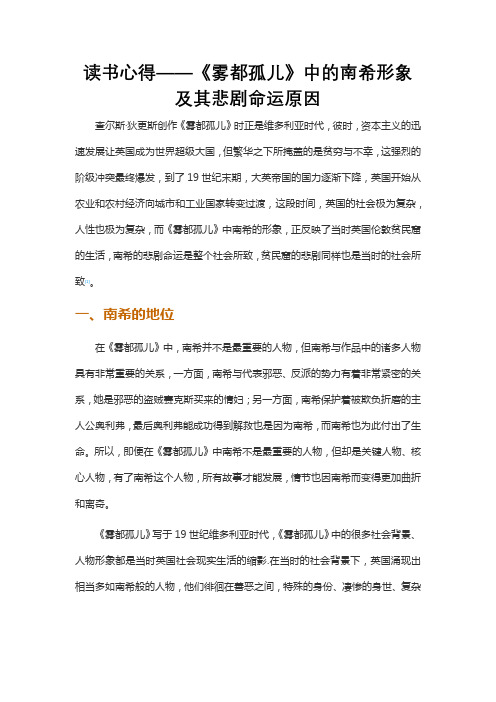
读书心得——《雾都孤儿》中的南希形象及其悲剧命运原因查尔斯·狄更斯创作《雾都孤儿》时正是维多利亚时代,彼时,资本主义的迅速发展让英国成为世界超级大国,但繁华之下所掩盖的是贫穷与不幸,这强烈的阶级冲突最终爆发,到了19世纪末期,大英帝国的国力逐渐下降,英国开始从农业和农村经济向城市和工业国家转变过渡,这段时间,英国的社会极为复杂,人性也极为复杂,而《雾都孤儿》中南希的形象,正反映了当时英国伦敦贫民窟的生活,南希的悲剧命运是整个社会所致,贫民窟的悲剧同样也是当时的社会所致[1]。
一、南希的地位在《雾都孤儿》中,南希并不是最重要的人物,但南希与作品中的诸多人物具有非常重要的关系,一方面,南希与代表邪恶、反派的势力有着非常紧密的关系,她是邪恶的盗贼赛克斯买来的情妇;另一方面,南希保护着被欺负折磨的主人公奥利弗,最后奥利弗能成功得到解救也是因为南希,而南希也为此付出了生命。
所以,即便在《雾都孤儿》中南希不是最重要的人物,但却是关键人物、核心人物,有了南希这个人物,所有故事才能发展,情节也因南希而变得更加曲折和离奇。
《雾都孤儿》写于19世纪维多利亚时代,《雾都孤儿》中的很多社会背景、人物形象都是当时英国社会现实生活的缩影.在当时的社会背景下,英国涌现出相当多如南希般的人物,他们徘徊在善恶之间,特殊的身份、凄惨的身世、复杂的性格使南希在《雾都孤儿》中成为独一无二的特殊存在,与作品中其他的纯善或者纯恶的人物相比,南希这个角色也吸引了更多人的探索与研究。
二、南希的形象分析南希在很小的时候就失去了双亲,是个可怜的孤儿,年幼无依的南希被扒手团伙收留。
长大后,南希被强盗赛克斯买下,成为赛克斯的情妇,自此,南希的一生都被牢牢握在赛克斯的手里,也正是因为如此,才会在小说的开头看到在费金的指示下费尽心机把已经逃出贼窟的主人公奥利弗诱逼回贼窟中的赛克斯和南希。
这个时候的南希,大概也是一个恶人的形象。
奥利弗重新陷入贼窟以后,遭受费金的毒打和其他盗贼团伙的欺负,此时,南希又勇敢地挺身而出,护在奥利弗的面前,保护奥利弗。
南希性格分析
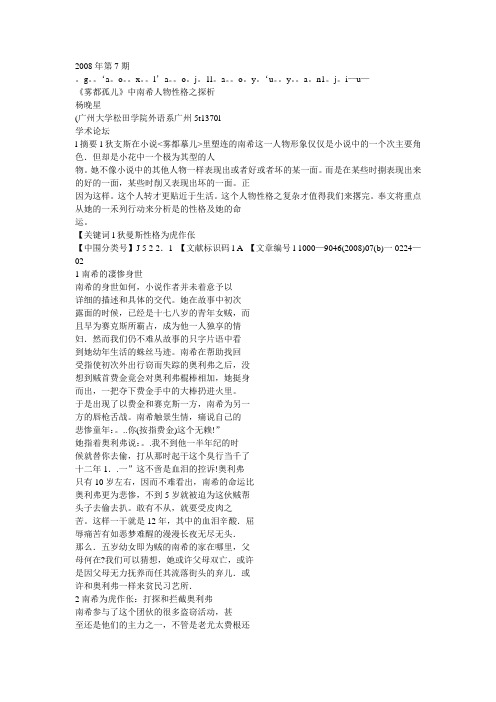
2008年第7期。
g。
‘a。
o。
x。
l’a。
o。
j。
1l。
a。
o。
y。
‘u。
y。
a。
n1。
j。
i—u—《雾都孤儿》中南希人物性格之探析杨晚星(广州大学松田学院外语系广州5t1370l学术论坛l摘要l狄支斯在小说<雾都摹儿>里塑连的南希这一人物形象仅仅是小说中的一个次主要角色.但却是小花中一个极为其型的人物。
她不像小说中的其他人物一样表现出或者好或者坏的某一面。
而是在某些时捌表现出来的好的一面,某些时削又表现出坏的一面。
正因为这样。
这个人转才更贴近于生活。
这个人物性格之复杂才值得我们来撂完。
奉文将重点从她的一禾列行动来分析是的性格及她的命运。
【关键词l狄曼斯性格为虎作伥【中围分类号】J 5 2 2.1 【文献标识码l A 【文章编号l 1000—9046(2008)07(b)一0224—021南希的凄惨身世南希的身世如何,小说作者并未着意予以详细的描述和具体的交代。
她在故事中初次露面的时候,已经是十七八岁的青年女贼,而且早为赛克斯所霸占,成为他一人独享的情妇.然而我们仍不难从故事的只字片语中看到她幼年生活的蛛丝马迹。
南希在帮助找回受指使初次外出行窃而失踪的奥利弗之后,没想到贼首费金竟会对奥利弗棍棒相加,她挺身而出,一把夺下费金手中的大棒扔进火里。
于是出现了以费金和赛克斯一方,南希为另一方的唇枪舌战。
南希触景生情,痛说自己的悲惨童年:。
..你(按指费金)这个无赖!”她指着奥利弗说:。
.我不到他一半年纪的时候就替你去偷,打从那时起干这个臭行当千了十二年1..一”这不啻是血泪的控诉!奥利弗只有10岁左右,因而不难看出,南希的命运比奥利弗更为悲惨,不到5岁就被迫为这伙贼帮头子去偷去扒。
敢有不从,就要受皮肉之苦。
这样一干就是12年,其中的血泪辛酸.屈辱痛苦有如恶梦难醒的漫漫长夜无尽无头.那么.五岁幼女即为贼的南希的家在哪里,父母何在?我们可以猜想,她或许父母双亡,或许是因父母无力抚养而任其流落街头的弃儿.或许和奥利弗一样来贫民习艺所.2南希为虎作伥:打探和拦截奥利弗南希参与了这个团伙的很多盗窃活动,甚至还是他们的主力之一,不管是老尤太费根还是她所爱的但是后来却亲自把他送到死神手里的赛克斯都不得不对她有所畏惧。
- 1、下载文档前请自行甄别文档内容的完整性,平台不提供额外的编辑、内容补充、找答案等附加服务。
- 2、"仅部分预览"的文档,不可在线预览部分如存在完整性等问题,可反馈申请退款(可完整预览的文档不适用该条件!)。
- 3、如文档侵犯您的权益,请联系客服反馈,我们会尽快为您处理(人工客服工作时间:9:00-18:30)。
《Oliver Twist》is one of my favourite novels, the characters and the delicate stories move me deeply.《Oliver Twist》, a realistic novel wrote by English writer Dickens is published in 1838. In this novel, Nancy’s character is complex and ambiguous, and she is just like a unit of angle and evil.
On the one hand, she has done numerous crimes under control of Fagin as a young female thief. The first thing which can prove her evil is her effort in the process of recapturing Oliver Twist. Her twice courses of action can prove that the evil inside of her characteristics. On the other hand, she tries all her best to help Oliver out from the thief gang with the awareness of disgrace in herself and evil in her fellow gang, gradually, she wakes up and regrets, stands up and defenses against evil and oppression. Nancy’s good nature mainly embodies in her protection of little Oliver. These words are enough to show her kindness to shock the readers. At last, she overcomes evil by making the sublimating of spirit and break through of nature. It’s just this double nature that well reflects the reality at that time.
Nancy in Oliver Twist has also become the most typical image in the literature field. Nancy is not just a signal of simple character but a vivid and unique figure which leaves deepest impression to readers. The significance lies in a scathing indictment of the capitalist society. In despite of the happy ending of Oliver painted a layer of bright color for the novel, it will never cover up critical significance of Na ncy’s double character.。
